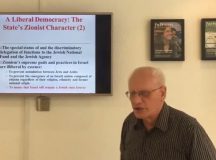As Israel goes to the polls for the second time in six months, it is time to revisit some old debates about electoral reform, argues David Newman of Ben Gurion University. Future Israeli leaders, he points out, need to be able to put together a government within a few days of the elections, with more than a slender majority of just one or two seats, and to govern for a minimal period of 4-5 years before once again turning to the people. Newman critically reviews the major reform proposals of recent Israeli history – electoral constituencies, direct elections for Prime Minister, and the raising of the electoral threshold – and assesses their relevance for today’s political conjuncture.
There is one finding common to all of the polls – and there are many – which have attempted to predict the outcome of Israel’s second elections in five months: there will not be sufficient seats for either of the two major party leaders – Benjamin Netanyahu or Benny Gantz – to form a governing coalition of 61 seats, whoever ends up as leader of the largest party. Despite the various mergers between some of the smaller parties, the right wing splinter factions or the Arab lists, the overall division between the blocs remains largely unchanged although, if the polls are to be believed (which is not necessarily the case) then the party of Avigdor Lieberman could well hold the balance of power, enabling him to be either the kingmaker or the King executioner.
If, as may well happen, it will take Netanyahu a further one to two months to somehow put together the shakiest of coalition governments, it will have been almost a year since the initial dispersal of the Knesset and the calling of the April elections until a new government is sworn in. This is unacceptable for a democracy, for which stability of government and the ability to govern in a smooth fashion is as important as is the principles of proportionality and of achieving as broad a representation of the different interests and sectors in society as is possible.
As someone who occasionally teaches comparative electoral studies, I am fortunate in being able to discuss at length the two electoral systems with which I am most familiar – the British and the Israeli. The two systems are diametrically opposed to each other in that the British system sacrifices proportionality for the stability of government (at least that was the case until BREXIT), while the Israeli system sacrifices stability and smooth governance for the principle of proportionality. They are both exceptional in their total reliance on systems which do not provide internal checks and balances to ensure that both objectives are met to as great an extent as possible.
The History of Electoral Reform Proposals in Israel
It is perhaps surprising that despite the exceptional decision to call an immediate second election, despite the knowledge that the overall result is not going to be greatly different from the first one, there has not been any renewed debate about the need for significant electoral reform in Israel. While Netanyahu has been criticised for not allowing the President to exercise his powers and call upon Gantz to try and put a government together following Netanyahu’s failure, it is clear to all that Gantz would have been unable to succeed, with or without the cooptation of the Arab parties, which Gantz was clear that he had no intention of attempting. So while there may not have been an alternative to holding another round of elections, what is the point if the system remains the same and the expected result does not offer any new options for forming a government?
It is a catch-22 situation which requires fresh thinking on the need for electoral reform, not reform which favours one political flavor, but one which will enable future Israeli leaders to put together a government within a few days of the elections, one which will have more than a slender majority of just one or two seats and which can not be brought down all too easily, one which will be able to govern for a minimal period of four to five years before once again turning to the people.
The system adopted by most countries is a variant on mixed electoral systems, with combinations of multi member constituencies (Britain has single member constituencies, Israel doesn’t have any constituencies), party lists and, in many cases, significantly higher lower electoral thresholds to ensure that the smallest of factions and splinter parties have to combine with other small parties over what unifies them, rather than fragment over the nuances which divide them. Experience shows that this allows for governments to change and for elections to be called at intervals of every four or five years, enabling governments to get on with what they were elected to do – govern the country – instead of expending most of their time and energy in holding the coalition together.
Electoral reform is by no means a new topic on the Israeli political agenda. As far back as the 1950’s Prime Minister David Ben-Gurion was a supporter of reform, but the rest of his ruling party, the strong armed Mapai party of Golda Meir, Levi Eshkol and Pinchas Sapir, strongly rejected any such moves. They were not prepared to sacrifice their single party hegemony and their own renewable personal power for the sake of greater democratisation and enfranchisement of those groups who remained powerless for the first thirty years of Statehood.
Menachem Begin’s rise to power in 1977 was, for many, a signal that the existing system with all its flaws, worked. Direct proportionality meant that groups with strong sectoral interests – be they religious, be they Arab, or be they (at that time) under represented Mizrachi-Oriental groups in the periphery, could achieve power if they – the second and third generations of politically aware young adults who did not feel themselves beholden to the Mapai elites – organised along party political lines. Indeed, 1977 was the only date in Israel’s political history where a true ‘revolution’ could be said to have taken place, replacing Israel’s one party hegemonic governments with a real alternative, one which has, in recent years, replaced the old hegemony of the left with a new hegemony of the right.
But the 1980s and 1990s gave rise to a situation in which governments became even shakier than before. Small parties of no more than one or two Knesset members could hold entire governments to ransom. The country had to resort to the establishment of ‘national unity governments’ with the position of Prime Minister being rotated amongst the two major party leaders – albeit in the name of unity but in effect bringing about governments of national paralysis where no major policy decisions could be undertaken. This was especially the case concerning the Arab-Israel conflict, the area within which the greatest differences between the Israeli definitions of what constitutes ‘right’ and ‘left’ exist.
Things came to a head following the attempt by Shimon Peres to bring down the national unity government in 1990 and to replace it with a Labour Party led government with the support of the religious and orthodox parties, including the new player on the block, the Shas party. But in a rousing speech by the leader of orthodox Jewry at the time, Rabbi Shach, Peres’s plans came apart and he was left without a government and, shortly afterwards without a party to lead as his long term rival Yitzchak Rabin – who accused him of a ‘dirty trick’ – replaced him as party leader, won the next election and led Israel towards the Oslo Accords.
The then President Chaim Herzog, a strong supporter of electoral reform, came as close to intervening in the political process as any President has ever done and called for change within the electoral system. The 1980s and 1990s gave rise to intensified debate, accompanied by detailed proposals, and even one short lived attempt, at changing the country’s electoral system, but here we are some thirty years on and the basic system remains pretty much what it always has been, and it is giving us the same problems that we have experienced throughout the country’ political history.
Reform 1: Electoral Constituencies
There was much discussion about the need for constituencies – electoral districts – in a country where the entire country is a single constituency.
For Constituencies
The claim that the country’s peripheral regions – the Negev and the Galilee – remain relatively undeveloped and starved of resources because of the lack of regional representation by local members of Parliament was a constant theme. With few exceptions, members of the Knesset resided in the metropolitan centre of the country, Jerusalem and Haifa, close to the party apparatus rather than the constituents, who had little or no say in how they were chosen. Proposals for a mixed system in which half of the Knesset would be chosen through twenty or thirty multi member constituencies, and the remainder from national party lists, were discussed at length. Two versions were proposed, one which split the constituency and national seats 50/50 (60 seats for each), another which proposed two thirds (80 seats) from the constituencies because of the importance of regional representation and only a third from the national lists.
The role of the national lists were to ‘top up’ the overall representation in the Knesset according to the proportion of votes each party received at the nation wide level, thus ensuring a high level of proportionality even if the constituency results would favour the larger parties – who would come out on top in each of the districts. Thus, as has been evidenced in almost all countries employing variations of this system, the ‘topping up’ process gives more seats to the smaller parties. This, in turn, would endanger the status of the party leaders of the larger parties, who would prefer to run on the national list rather than spend their time garnering support within local constituencies, but who may find themselves without any seat in the Knesset. At one point it was even suggested that candidates could choose to run on both the constituency and the national list, a form of insurance policy to ensure their Knesset position. Only in Israel had such a proposal been suggested, while in the many countries employing similar systems, the candidate has to decide which of the two lists was most appropriate for them, and the risk they were prepared to take in order to be elected.
Against Constituencies
There were equally strong arguments against establishing electoral constituencies. In the first place, the question of who would determine the boundaries of the electoral areas and to what extent gerrymandering would take place, especially in areas of high Arab or religious concentration, was clearly on the agenda. Would the task of demarcating the electoral boundaries fall to the politicians themselves or to a neutral commission of judges, geographers and ‘neutral’ think tanks? Would representatives of all the sectoral interests have a say in the demarcation of the boundaries, thus ensuring the ‘packing’ of electoral districts in such a way as to ensure their representation, or would the representatives of the larger parties try to ‘crack’ the ethnic and religious areas in such a way that they would end up being a minority in every constituency and end up with no constituency representatives at all? This was a particular problem in areas such as the Galilee (Arab concentrations), Bnei Brak and Jerusalem (religious and ultra orthodox concentrations).
Another counter argument heard was the fact that Israel is a small country, ‘everybody knows everybody from the army’ and that it was always possible for local government officials to directly contact the government ministers and even the Prime Minister as and when necessary. The idea that central government were unaware of the needs and relative deprivation of the development towns and peripheral regions of the country, was dismissed as being out of touch with the way Israeli society works. Moreover, the question of whether West Bank – Judea and Samaria settlements would also have their own regional representation raised larger international questions of legitimacy and the de facto transfer of civilian functions to the ‘occupied territories’. It was one thing allowing each individual regardless of where he/she resided, the vote – even if it was in the Occupied Territories. It was quite another to formally recognise these areas as part of the civilian functions of the state which claimed, to the outside world, that it had not broken any international law by not formally annexing the territories.
Beyond computerised simulations of the expected results of different forms of the mixed system, the issue of constituencies never went any further, and has not been discussed at any length in the subsequent 25 years. This was also probably due to the fact that from the 1980s onwards, a new group of national politicians, all of whom had previously been local government mayors of development towns – such as Moshe Katzav (Qiryat Malakhi), David Magen (Qiryat Gat) or Meir Shitrit (Yavneh) (to name but a few) – emerged from within the Likud, along with David Levy who had started his political career as a labor activist in Bet Shean, eventually becoming Deputy Prime Minister and holding many other senior ministerial portfolios. Unlike a few Mapai counterparts, such as Avraham Baige Shochat, the legendary Mayor of Arad, who, once promoted to the national ranks promptly left the development town in which he lived and moved to Tel Aviv, these Likud – Mizrachi politicians remained loyal to the towns from which they had emerged. This also gave rise to the argument that the era in which the voice of the periphery was unheard had passed – although judging by current indices of socio economic development it would appear that the gap between the wealthy centre (core) and the less developed periphery, remains as large, if not larger, than it was during that period.
Reform 2: Raising the Lower Electoral Threshold
One reform that has actually been put in place has been the gradual raising of the lower threshold for any party list to gain entry to the Knesset. For much of Israel’s history, the lower threshold was set at the extremely low level of one per cent. This resulted in any party or splinter faction which decided to run alone, gaining one per cent of the eligible votes, entering the Knesset with a minimum two seats (one per cent of 120 seats rounded up). These smallest of factions were often need to prop up a government coalition of 61 or 62 seats, meaning they held disproportionate power relative to their actual size. They demanded huge resources for their respective small constituencies, along with ministerial positions around the government table. The more parties required to prop up a coalition, the larger the size of the Cabinet and the number of independent ministries. Time after time, proposals and promises aimed at limiting the number of ministries to 17 or 18 (itself one in every six members of Knesset) have been swept aside as party leaders have to make ministerial promises to a large number of small parties as a guarantee to have them supporting the government coalition. Each independent Ministry requires a minimum of tens of millions of dollars just to fund the key administrative positions and office buildings, resources which could have been distributed to alleviate other welfare, educational and health problems. The oft heard mantra from the government power brokers to counter the criticism of wasted resources is that ‘this is the price we have to pay for democracy’.
Notwithstanding, Israel has raised its electoral threshold three times since the early 1990s. In 1992 it was raised from 1 to 1.5 per cent, in 2003 to 2 per cent and most recently to 3.25 per cent in 2014. Given the rise in the population, this now means that a party requires approximately 140,000 votes to get into the Knesset, giving them a minimum of four seats. Effectively, this has put an end to the smallest of parties, encouraging parties of similar political persuasion to coalesce into larger parties over the issues which unite them rather than splinter and fragment over the minor nuances which divide them. This is true of the Arab parties, the Haredi (ultra-Orthodox) parties and, as would appear to be the case in the forthcoming September elections, with the many right wing factions which have appeared on the political scene in recent years, each vying with the other to propose intransigent policies, arguing that the Likud under Netanyahu is not strong enough in dealing with the Palestinians and the issue of the territories – which some of them propose to annex if they were to hold the reigns of power.
For their part, the smaller parties argue that the raising of the lower threshold is no more than an anti-democratic attempt to prevent them from gaining seats. This argument has been advanced in particular by the representatives of the Arab parties who see it as an attempt to reduce Arab representation within the Knesset. But both the Arab and the Haredi parties have demonstrated that by combining into a single electoral unit (requiring a great deal of internal negotiating over the composition of the joint party list) they are able to obtain significant representation – in both cases double figures – constituting a more powerful lobby than when they operate as small party factions and splinter groups. Following the failure of some of the right-wing splinter factions in the April elections, they have also coalesced into a single right-wing extremist party which, they believe, will be a natural coalition partner for Netanyahu should he emerge again as the leader of the largest party.
The larger parties are ambivalent about the coalescence of smaller parties. On the one hand it is easier for them to deal with fewer, but larger, parties when negotiating a coalition agreement. On the other hand, the coalescence of the smaller right-wing parties means that they will gain seats which would otherwise have gone to the larger parties in the final share out had they failed to reach the 3.25 per cent threshold. Netanyahu can expect to lose some seats as a result of the right-wing factions coming together in a single party, while at the same time ensuring that the right-wing bloc maintains, perhaps even increases its overall power. However, in terms of the broader democratic processes, having fewer, but larger parties, without sacrificing the democratic interests of major sectoral interests, is generally seen as a positive development.
So far, the raising of the threshold to 3.25 per cent has not denied any of the main sectoral groups access to power, and will not for as long as they agree to coalesce around issues of common interest. It has been argued that the threshold could be raised even higher – as much as five per cent and more – without harming such interests.
Reform 3: Direct Elections of Prime Minister
For a short period in the 1990s a major change in the electoral law was introduced, allowing for direct elections of the Prime Minister. The Israeli voter was presented with the opportunity of two votes, one for Prime Minister and one for the party of his/her choice. In both 1996 and 1999, elections were held in this way, while in 2001 elections were held for Prime Minister alone, with the Knesset remaining unchanged, following Prime Minister Barak’s decision to call for special elections for Prime Minister. He was defeated by Ariel Sharon who, in turn, supported the Knesset decision in 2001 to revert to the previous one-vote parliamentary system, albeit with some minor reforms.
The original decision to opt for direct elections of prime minister was aimed at enabling the Prime Minister to exercise greater executive power without having to resort to the Knesset to approve every one of his decisions, most notably the appointment of the cabinet and the ability to include a larger number of non-political professional experts to key government positions. This partial separation of powers was modeled on an incorrect understanding of both the American and French presidential systems, in which the president is not a member of the Parliament but exercises significant executive powers. However, in the Israel case, the prime minister remained a member of the Knesset and was still reliant on the approval of the ruling government coalition for the passing of laws. The need to create coalition governments did not become any easier, in certain respects it became even more difficult as the vote for parties fragmented even further than before, resulting in the same degree of instability that had previously been the case.
It had been thought, again based on a study of other countries operating similar split systems of government, that once an individual had voted for a prime ministerial candidate, he/she would almost automatically vote for the same party with the second vote, thus reducing the selection of small parties, none of which put forward a candidate for Prime Minister. But the Israeli experience proved otherwise. The electorate decided to use their second vote to opt for smaller parties which, in the past, they may not have chosen. Given their choice of a prime minister from one of the two larger parties, they decided to spread their wings and opt for alternative parties which were closer to their narrow ideological interests – for example one could vote for a right or left-wing prime minister as defined along the Israel-Palestine conflict spectrum, while at the same time voting for a religious or ethnic party which would represent their daily life style interests.
Given what was perceived as a failure of the electoral reform, the Knesset decided to revert to the old system, with all of its faults, and in both 2003 and 2005 Ariel Sharon was elected as Prime Minister, first as head of the Likud party and then as head of the newly formed Kadima party. It is argued that the new system, for all of its initial faults, had not remained in place long enough for political behaviour amongst the electorate to undergo change, such change often requiring at least a decade and a whole new generation of younger voters. Notwithstanding, this attempt at reform has been judged as a failure and probably explains why such little attention has been paid to further attempts at electoral reform in the intervening period.
Is electoral reform for Israel still on the political agenda?
Electoral reform is not presently on the Israeli political agenda. However, if after holding two elections within the space of five months it proves yet again impossible to put together a ruling coalition, it will be necessary to revisit the subject, to put into place a system which will allow for greater governmental stability. What this may consist of is unclear. Constituencies are not on the agenda today. The further raising of the lower threshold to ensure that only large and medium sized parties are elected (necessitating the coalescence of many of the smaller parties) is a possibility, at least as high as 5-6 per cent. The role of the President in deciding who ultimately is asked to form the government coalition may also be challenged. Indeed it is because Netanyahu did not want President Rivlin to ask Benny Gantz to try and put together a majority government following Netanyahu’s failure to do so, that Netanyahu decide to immediately call for yet another round of elections.
What is perhaps the most disturbing aspect of Israel’s recent elections is the fact that rates of participation have dropped from highs of over 80 per cent in the 1950s and 1960s, to 70 plus per cent in the 1970s and 1980s, to as low as 63 per cent a decade ago. There has been a small upwards movement in the previous two elections but overall participation is still much lower than it was 30 to 40 years ago, in a country where it is often joked that every taxi driver and every Friday night dinner discusses nothing else than politics. This is clearly no longer the case. Much of the public has become dissatisfied with the way the system operates, because of the growing perception of politicians as out for themselves rather than serving the public good, and because of the inability of successive governments to deal with the ongoing Israel-Palestine conflict. A country where participation rates are on the decline indicate an unhealthy political system. Should the second elections in less than six months bring about yet another decrease in participation rates, it would behove the powers that be to revisit the choices of election system which are put before the Israeli public in years to come.





































As is well known, the adopted in Israel closed list variant of party-list proportional representation (PR) system allows voters (effectively) only vote for political parties as a whole and thus have no influence on the party-supplied order in which party candidates are elected. There is a widely accepted opinion that this type of PR provides a route for extremists to force their way into the political mainstream by weakening the link between the elected representative and his or her constituency. An alternative would possibly be adoption of an open list PR system in Israel. It would be helpful I think to know Prof. Newman’s opinion about adopting this possibility of performing electoral reform in the country